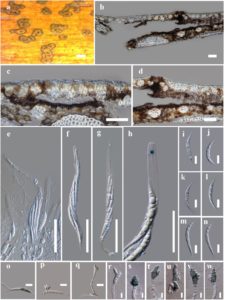Oxydothis metroxyli S. Konta & K.D. Hyde [as ‘metroxylonis‘], in Konta, Hongsanan, Tibpromma, Thongbai, Maharachchikumbura, Bahkali, Hyde & Boonmee, Mycosphere 7(9): 1436 (2016)
Index Fungorum number: IF 552543; Facesoffungi number: FoF 02704
Etymology – The specific epithet refers to the host genus Metroxylon.
Saprobic on petiole of Metroxylon sagu Rottb. (Arecaceae). Sexual morph: Ascomata 716–1,580 μm diam. (x̅ = 1,091 μm diam., n = 40), solitary or aggregated, mostly solitary when young, becoming grouped at maturity, immersed, comprising non-blistering areas, axis oblique or perpendicular to the host surface, with central papilla. Peridium 10–33 μm (x̅ = 21 μm, n = 10), outer cells merging with the host epidermal cells, comprising dark brown to black, cells of textura angularis. Asci 165–181 × 9–15 μm (x̅ = 175 × 14 μm, n = 10), 8-spored, unitunicate, cylindrical-clavate, pedicellate, with a J+, wedge-shaped, subapical ring. Ascospores 47–57 × 4–6 μm (x̅ = 52 × 5 μm, n = 20), 2–3-seriate, fusiform, tapering gradually from the center to the ends, centrally 1-septate, not constricted at the septum, with pointed ends, hyaline, with large multi-guttules in each cell, smooth-walled. Asexual morph: Undetermined. Appressoria 14–31 μm high × 6–17 μm diam. (x̅ = 25 × 10 μm, n = 10) solitary, single, hyaline to light green, irregular in shape, thick-walled.
Culture characters – Ascospores germinating on MEA within 24 hours and germ tubes developing appressoria. Colonies on MEA olivaceous, rough, producing rudimentary ascomata at the center, slightly fluffy at the margins, hyphae, septate, branched, smooth-walled.
Material examined – Thailand, Krabi, on dead petiole palm, Metroxylon sagu Rottb. (Arecaceae), 8 December 2014, S. Konta, KBR04e (MFLU 15-0029, holotype; HKAS 95040, isotype); ex-type living culture, MFLUCC 15-0283.
Notes – Oxydothis metroxylonis is similar to Oxydothis oraniopsis in ascospore shape, however, it is distinct in having globose to subglobose, non-blistering ascomata, ellipsoidal in transverse-section, asci with a J+, wedge-shaped apical ring, and multi-guttulate ascospores. Oxydothis oraniopsis forms dome-shaped, subglobose to cylindrical ascomata and have J+ and discoid ascal rings. Phylogenetic analysis place Oxydothis metroxylonis as a basal clade clustering with O. calamicola, O. cyrtostachicola Hidayat et al., O. metroxylinicola and O. palmicola with moderate support (78% ML, 0.94 PP), but the species have very different ascomata.

Fig 1. Oxydothis metroxylonis (holotype) a. Ascomata on host substrate. b–c. Section of ascomata. d. Peridium. e–g. Asci. h. J+ reaction of the apical ring in Melzer’s reagent. i–n. Ascospores. o–q. Germinating spores. r–w. Appressoria. Scale bars: a = 1 mm, b–g = 50 μm, h = 20 μm, o–q = 10 μm, r–w = 5 μm.
